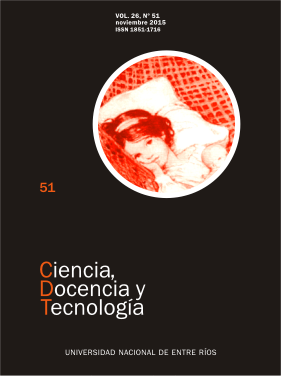Abstract
Water erosion has high incidence in agricultural production. In this work, a qualitative-quantitative method for assessing the quality of the cultural profile in environments degraded by water erosion is proposed. The method was applied in ten environments within a farm of the southern of Santa Fe, Argentina. Soil is a Typic Argiudoll and average annual rainfall is about 980 mm, the R value of the USLE is 550 MJ mm ha-1 h-1. Signs of water erosion were surveyed and observation wells were made in each environment. The categories for assessing the quality of the cultural profile (VCPC) were: Poor, Fair, Good and Very Good. No Very Good cultural profiles were found and 60% of the evaluated area show cultural profiles between Poor and Fair. The method was effective to discriminate between different situations affected by water erosion process.
References
BALL, B. C.; BATEY, T; MUNKHOLM, L. J. (2007). Field assessment of soil structural quality -a development of the Peerlkamp test, en: Soil Use and Management, 23:329-337.
BESTELMEYER, B. T. (2006). Threshold concepts and their use in rangeland management and restoration: The good, the bad, and the insidious, en: Restoration Ecology. 14: 325-329.
CANILLAS, E. C.; SALOKHE, V. M. (2002). A decision support system for compaction assessment in agricultural soils, en: Soil y Tillage Research, 65 (2): 221-230.
CARRIZO, M. E.; PILATTI, M. A.; ALESSO, C. A.; IMHOFF, S. (2012). Atributos químicos de suelos argiudoles cultivados y no cultivados del departamento Las Colonias (Santa Fe) , en: Ciencia del Suelo, 29: 173-179.
CHATTERJEE, A.; LAL, R. (2009). On farm assessment of tillage impact on soil carbon and associated soil quality parameters, en: Soil y Tillage Research, 104(2): 270-277.
DORAN, J. E.; PARKIN, T. B. (1996). Quantitative indicators of soil quality: A minimum data set. In: Doran, J. W. & Jones, A. J. (eds.) , en: Methods for assessing soil quality. SSSA Spec. Publ. Nº 49, 25-37. Madison, USA.
HUSSAIN, I.; OLSON, K. R.; WANDER, M. M.; KARLEN, D. L. (1999). Adaptation of soil quality indices and application to three tillage systems in southern Illinois, en: Soil y Tillage Research, 50(3): 237-249.
INTA – Instituto Nacional de Tecnología Agropecuaria (2009). Indicadores de calidad ambiental para el manejo sustentable de los agroecosistemas. Primer Documento Base de Trabajo Taller. Buenos Aires, Argentina. 121 p.
MONTICO, S.; DI LEO, N. (2010). Desarrollo de un método simplificado para la valoración del estado edáfico superficial en agricultura. En: Actas CD XXII Congreso Argentino de la Ciencia del Suelo. Rosario, Argentina.
MONTICO, S.; DI LEO, N. (2012). Clasificación de ambientes erosionados para la aplicación de tecnologías de agricultura de precisión. En: Actas VI Jornada de Ciencia y Tecnología UNR. Rosario, Argentina.
SHUKLA, M. K.; LAL, R; EBINGER, M. (2006). Determining soil quality indicators by factor análisis, en: Soil y Tillage Research, 87: 194-204.
ZERPA, G. (2007). Degradación de suelos en uso pasturil. Tesis para el grado de Magister en Manejo y Conservación de Recursos Naturales. Facultad de Ciencias Agrarias. UNR, Rosario, Argentina.
The authors retain the copyright and grant the journal the right to be the first publication of the work, as well as licensing it under a Creative Commons Attribution License that allows others to share the work with an acknowledgment of the authorship of the work and publication initial in this magazine. All content is published under the Creative Commons 4.0 international license: Attribution-Non-Commercial-Share Alike.

